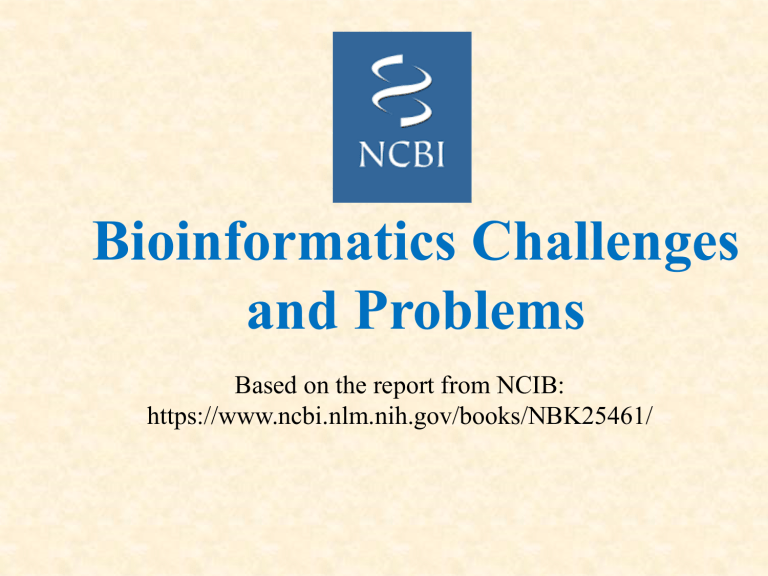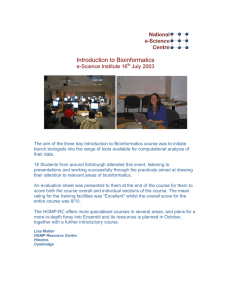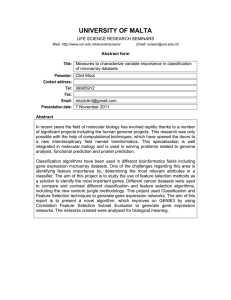
Bioinformatics Challenges and Problems Based on the report from NCIB: https://www.ncbi.nlm.nih.gov/books/NBK25461/ GRAND CHALLENGES IN COMPUTATIONAL BIOLOGY • Protein structure prediction • Homology searches • Multiple alignment and phylogeny construction • Genomic sequence analysis and genefinding OPPORTUNITIES IN MOLECULAR BIOMEDICINE IN THE ERA OF TERAFLOP COMPUTING (Klaus Schulten et al.) 1. Study protein-protein and protein-nucleic acid recognition and assembly 2. Investigate integral functional units (dynamic form and function of large macromolecular and supramolecular complexes) 3. Bridge the gap between computationally feasible and functionally relevant time scales 4. Improve multiresolution structure prediction 5. Combine classical molecular dynamics simulations with quantum chemical forces 6. Sample larger sets of dynamical events and chemical species 7. Realize interactive modeling 8. Foster the development of biomolecular modeling and bioinformatics 9. Train computational biologists in teraflop technologies, numerical algorithms, and physical concepts 10. Bring experimental and computational groups in molecular biomedicine closer together. WORKSHOP ON MODELING OF BIOLOGICAL SYSTEMS (Peter Kollman and Simon Levin) Challenging Issues That Span All Areas of Modeling Systems • Integrating data and developing models of complex systems across multiple spatial and temporal scales • • • • • Scale relations and coupling Temporal complexity and coding Parameter estimation and treatment of uncertainty Statistical analysis and data mining Simulation modeling and prediction • Structure-function relationships • • • • • • Large and small nucleic acids Proteins Membrane systems General macromolecular assemblies CeIlular, tissue, organismal systems Ecological and evolutionary systems • Image analysis and visualization • • • Image interpretation and data fusion Inverse problems Two-, three- and higher-dimensional visualization and virtual reality • Basic mathematical issues • • • • • Formalisms for spatial and temporal encoding Complex geometry Relationships between network architecture and dynamics Combinatorial complexity Theory for systems that combine stochastic and nonlinear effects often in partially distributed systems • Data management • Data modeling and data structure design • Query algorithms, especially across heterogeneous data types • Data server communication, especially peerto-peer replication • Distributed memory management and process management WORKSHOP ON NEXT-GENERATION BIOLOGY: THE ROLE OF NEXT-GENERATION COMPUTING (Shankar Subramaniam and John Wooley) Exemplar Challenges for Bioinformatics and Computational Biology 1. Full genome-genome comparisons 2. Rapid assessment of polymorphic genetic variations 3. Complete construction of orthologous and paralogous groups of genes 4. Structure determination of large macromolecular assemblies/complexes 5. Dynamical simulation of realistic oligomeric systems 6. Rapid structural/topological clustering of proteins 7. Prediction of unknown molecular structures; protein folding 8. Computer simulation of membrane structure and dynamic function 9. Simulation of genetic networks and the sensitivity of these pathways to component stoichiometry and kinetics 10. Integration of observations across scales of vastly different dimensions and organization to yield realistic environmental models for basic biology and societal needs TECHNOLOGIES FOR BIOLOGICAL COMPUTER-AIDED DESIGN (Masaru Tomita) 1. Enzyme engineering: to refine enzymes and to analyze kinetic parameters in vitro 2. Metabolic engineering: to analyze flux rates in vivo 3. Analytical chemistry: to determine and analyze the quantity of metabolites efficiently 4. Genetic engineering: to cut and paste genes on demand, for modifying metabolic pathways 5. Simulation science: to efficiently and accurately simulate a large number of reactions 6. Knowledge engineering: to construct, edit and maintain large metabolic knowledge bases 7. Mathematical engineering: to estimate and tune unknown parameters TOP BIOINFORMATICS CHALLENGES (Chris Burge et al.) 1. Precise, predictive model of transcription initiation and termination: ability to predict where and when transcription will occur in a genome 2. Precise, predictive model of RNA splicing/alternative splicing: ability to predict the splicing pattern of any primary transcript 3. Precise, quantitative models of signal transduction pathways:ability to predict cellular response to external stimuli 4. Determining effective protein-DNA, protein-RNA and protein-protein recognition codes 5. Accurate ab initio structure prediction 6. Rational design of small molecule inhibitors of proteins 7. Mechanistic understanding of protein evolution: understanding exactly how new protein functions evolve 8. Mechanistic understanding of speciation: molecular details of how speciation occurs 9. Continued development of effective gene ontologies-systematic ways to describe the functions of any gene or protein 10. (Infrastructure and education challenge) 11. Education: development of appropriate bioinformatics curricula for secondary, undergraduate, and graduate education EMERGING FIELDS IN BIOINFORMATICS (Patricia Babbitt) 1. Data storage and retrieval, database structures, annotation 2. Analysis of genomic/proteomic/other high-throughput information 3. Evolutionary model building and phylogenic analysis 4. Architecture and content of genomes 5. Complex systems analysis/genetic circuits 6. Information content in DNA, RNA, protein sequences and structure 7. Metabolic computing 8. Data mining using machine learning tools, neural nets, artificial intelligence 9. Nucleic acid and protein sequence analyses Other Challenges and Opportunities Available from: National Center for Biotechnology Information https://www.ncbi.nlm.nih.gov/books/NBK25461/

